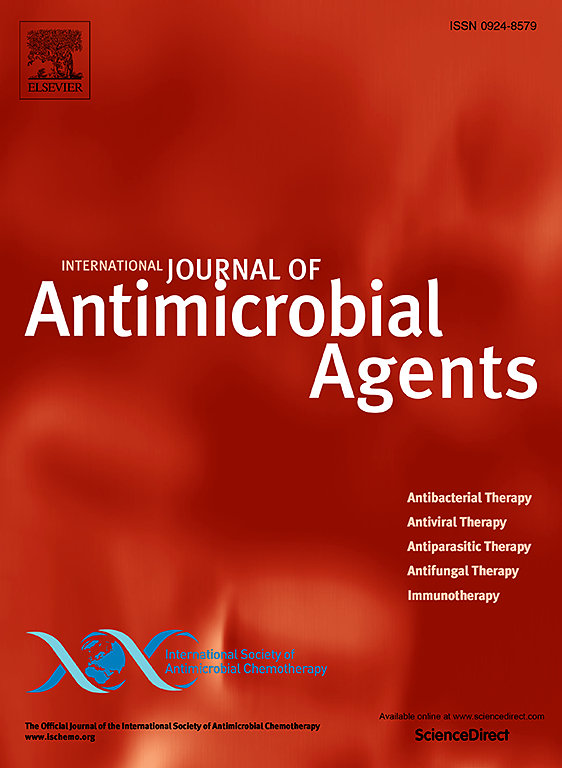Individualised amoxicillin-clavulanate dosing recommendations for critically ill children with augmented clearance after cardiac surgery
IF 4.6
2区 医学
Q1 INFECTIOUS DISEASES
International Journal of Antimicrobial Agents
Pub Date : 2025-04-15
DOI:10.1016/j.ijantimicag.2025.107513
引用次数: 0
Abstract
Objective
Children who undergo cardiac surgery are prone to postoperative infections for which amoxicillin-clavulanate is a cornerstone antibiotic. Nevertheless, amoxicillin-clavulanate pharmacokinetics have not been studied in infants and children after cardiac surgery so far. Antibiotic exposure might be highly variable in this population due to the impact of growth, maturation, and specific pathophysiological and surgery-induced alterations. The objective of this study was to develop evidence-based amoxicillin-clavulanate dosing recommendations based on population pharmacokinetic analysis and probability of target attainment simulations in children after cardiac surgery.
Methods
Critically ill children (aged 1 day to 15 y) who underwent cardiac surgery and who were treated postoperatively with amoxicillin-clavulanate (30–60 mg/kg/6 h based on the amoxicillin component, infused in 30 min) were included. Up to five amoxicillin and clavulanate blood samples were collected per dose at predefined sampling times. Population pharmacokinetics analysis was performed using nonlinear mixed effects modelling software NONMEM.
Results
We collected 316 amoxicillin and 287 clavulanate blood samples from 37 patients. A three-compartment model for amoxicillin and a two-compartment model for clavulanate best described pharmacokinetics, with allometric weight scaling and maturation functions added a priori to scale for size and age. Clearance estimates were remarkably high, except in patients receiving vasopressors, which decreased clearance of amoxicillin-clavulanate by a third. Using a pharmacokinetic/pharmacodynamic target of 50%fT>MIC of 8 mg/L, patients not on vasopressors warranted 4-hourly dosing to achieve adequate drug exposure due to augmented amoxicillin clearance. Only in patients treated with vasopressors was the standard 6-hourly dosing regimen sufficient to attain amoxicillin concentrations above the MIC for half of the dosing interval.
Conclusions
Current amoxicillin-clavulanate dosing regimens for critically ill children after cardiac surgery need to be updated to avoid subtherapeutic concentrations and clinical failure due to augmented clearance (ClinicalTrials.gov NCT02456974).
心脏手术后清除率增强的危重儿童个体化阿莫西林-克拉维酸剂量建议
目的:阿莫西林-克拉维酸酯是心脏手术的基础抗生素,儿童术后易发生感染。然而,阿莫西林-克拉维酸酯在婴儿和儿童心脏手术后的药代动力学尚未研究。由于生长、成熟和特定病理生理和手术引起的改变,抗生素暴露在这一人群中可能是高度可变的。本研究的目的是基于人群药代动力学分析和心脏手术后儿童目标实现概率模拟,制定基于证据的阿莫西林-克拉维酸剂量建议。方法采用阿莫西林-克拉维酸钠(30 ~ 60 mg/kg/6 h,根据阿莫西林成分,30 min内输注)治疗的危重患儿(1天~ 15岁)。在预定的采样时间内,每剂量最多采集5份阿莫西林和克拉维酸血液样本。使用非线性混合效应建模软件NONMEM进行群体药代动力学分析。结果37例患者共采集阿莫西林316份、克拉维酸287份血样。阿莫西林的三室模型和克拉维酸的两室模型最好地描述了药代动力学,异速体重标度和成熟函数先验地添加到尺寸和年龄的标度中。清除率估计非常高,除了接受血管加压药物治疗的患者,阿莫西林-克拉维酸酯的清除率降低了三分之一。使用50%的药代动力学/药效学目标,MIC为8mg /L,未使用血管加压药物的患者需要4小时给药,以获得足够的药物暴露,因为阿莫西林清除增强。只有在接受血管加压药物治疗的患者中,标准的6小时给药方案足以使阿莫西林浓度在一半的给药间隔内高于MIC。目前用于心脏手术后危重儿童的阿莫西林-克拉维酸给药方案需要更新,以避免亚治疗浓度和由于增强清除而导致的临床失败(ClinicalTrials.gov NCT02456974)。
本文章由计算机程序翻译,如有差异,请以英文原文为准。
求助全文
约1分钟内获得全文
求助全文
来源期刊
CiteScore
21.60
自引率
0.90%
发文量
176
审稿时长
36 days
期刊介绍:
The International Journal of Antimicrobial Agents is a peer-reviewed publication offering comprehensive and current reference information on the physical, pharmacological, in vitro, and clinical properties of individual antimicrobial agents, covering antiviral, antiparasitic, antibacterial, and antifungal agents. The journal not only communicates new trends and developments through authoritative review articles but also addresses the critical issue of antimicrobial resistance, both in hospital and community settings. Published content includes solicited reviews by leading experts and high-quality original research papers in the specified fields.

 求助内容:
求助内容: 应助结果提醒方式:
应助结果提醒方式:


